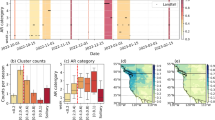Abstract
In practice, the annual series of streamflow peaks is generally preferred than the partial series for flood frequency analysis. Flood selection criteria for the partial series tend to be arbitrary and are limited in making allowances for catchment scale. This aspect appears to be a constraint to greater acceptance of the partial series approach. The aim of this paper is to define a scalable selection criterion that reduces ambiguity in flood selection by defining floods that exceed the daily average. An approach based on the volume delivery time (VDT), analogous to the tip interval time in tipping bucket raingauges, is described and tested for three rural catchments of various sizes in South East Queensland, Australia. The VDT approach produced discharge quantile estimates similar to the partial series based on the commonly-used monthly maxima except for minor, high frequency discharges at the small, more perennial catchment. A simplified approach based on average daily volume gave similar results to the VDT method.




Similar content being viewed by others
References
Adams CA, McMahon TA (1985) Estimation of flood discharge for ungauged rural catchments in Victoria. Proceedings of the 1985 Hydrology and Water Resources Symposium. I.E. Aust. Conf. Publication 85/2: 86–90
Ashkanasy NM, Tickle KS (1986) Partial series analysis: a theoretical and empirical examination. Proceedings of the 1986 Hydrology and Water Resources Symposium, Brisbane 25–27 November, 27–32
Beard LR (1974) Flood flow frequency techniques. Technical report CRWR no 19. Center for Research in Water Resources, University of Texas, Austin
Birikundavyi S, Rousselle J (1997) Use of the partial duration series for single-station and regional analysis of floods. J Hydro Eng 2:68–75
BOM (2012) Known floods in the Brisbane and Bremer River Basin including the cities of Brisbane and Ipswich. Bureau of Meteorology www.bom.gov.au/hydro/flood/qld/fld_history. Accessed November 2010
Cunnane C (1978) Unbiased plotting positions- a review. J Hydro 37:205–222
Cunnane C (1979) A note on the Poisson assumption in partial duration series models. Water Resour Res 15:489–494
IEAust (1987) Australian rainfall and runoff- a guide to flood estimation. I.E. Aust. Publication. Revision 1999
Jurasuriya MDA, Mein RG (1985). Frequency analysis using the partial series. Proceedings of the 1985 Hydrology and Water Resources Symposium. I.E. Aust. Conf. Publication 85/2:81–85
Kuczera G, Franks S (2006) Australian rainfall and runoff book IV estimation of peak discharge, chapter 2 At-site flood frequency analysis. Draft for review
Ladson A (2008) Hydrology—an Australian introduction. Oxford University Press, Melbourne
Langbein WB (1949) Annual floods and the partial duration series. Trans Amer Geophys Union 30:879–881
Laurenson, EM (1987). Back to basics on flood frequency analysis. Trans IE Aust Civil Eng CE29 (2):47–53
Lyne V, Hollick M (1979) Stochastic time-variable rainfall-runoff modeling. Proceedings of the 1979 Hydrology and Water Resources Symposium, I.E. Aust. Conf. Publication 79/10:89–92
Madsen H, Rasmussen PF, Rosbjerg D (1997) Comparison of annual maximum series and partial duration series methods for modeling extreme hydrological events 1. At-site modeling. Water Resour Res 33(4):747–757
McMahon TA, Finlayson BL (2003) Droughts and anti-droughts: the low flow hydrology of Australian rivers. Freshw Biol 48:1147–1160
Mohssen M (2009) Partial duration series in the annual domain. 18th World IMACS/MODSIM Congress, Cairns, Australia, 13–17 July, 2694–2700
Nadarajah S, Shiau JT (2005) Analysis of extreme flood events for the Pachang River, Taiwan. Water Resour Manag 19(4):363–374
Nathan RJ, McMahon TA (1992) Estimating low flow characteristics in ungauged catchments. Water Resour Manag 6:85–100
NERC (1975) Flood studies report vol. 1—hydrological studies. Natural Environment Research Council, London
Pilgrim DH, McDermott GE (1982) Design floods for small rural catchments in Eastern New South Wales. Trans IE Aust Civil Engineering CE24:226–234
Potter DJ, Pilgrim DH (1971) Flood estimation using a regional flood frequency approach Vol. 2 Report on Analysis Components. Australian Water Resources Council, Research Project 68/1, Hydrology of Small Rural Catchments, Snowy Mountains Engineering Corp
Rosbjerg D, Madsen H, Rasmussen PF (1992) Prediction in partial duration series with generalized pareto distributed exceedences. Water Resour Res 28(11):3001–3010
Sørup HJD, Madsen H, Arnbjerg-Nielsen K (2011) Markov chain modeling of precipitation time series: modeling waiting times between tipping bucket rain gauge tips. 12th International Conference on Urban Drainage, Porto Alegre, Brazil, 11–16 September 2011
Tan K-S, Chiew FHS, Grayson RB (2007) A steepness index unit volume flood hydrograph approach for sub-daily flow disaggregation. Hydro Processes 21:2807–2816
Tavares LV, da Silva JE (1983) Partial series method revisited. J Hydro 64:1–14
USGS (1982) Guidelines for determining flood flow frequency. Bulletin 17B, hydrological subcommittee. Office of Water Data Coordination, US Geological Survey, Department of Interior, Washington
Zakaria ZA, Shabri A, Ahmad UN (2012) Regional frequency analysis of extreme rainfalls in the West Coast of Peninsular Malaysia using partial L-Moments. Water Resour Manag 26(15):4417–4433
Author information
Authors and Affiliations
Corresponding author
Rights and permissions
About this article
Cite this article
Brodie, I. Using Volume Delivery Time to Identify Independent Partial Series Events. Water Resour Manage 27, 3727–3738 (2013). https://doi.org/10.1007/s11269-013-0377-1
Received:
Accepted:
Published:
Issue Date:
DOI: https://doi.org/10.1007/s11269-013-0377-1




